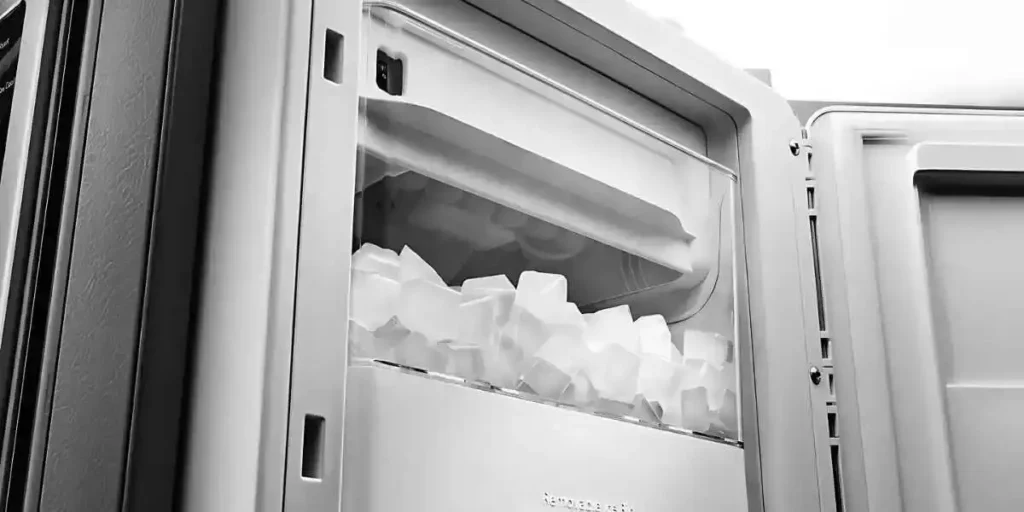Tired of your ice maker overflowing with water? Get ready for a cool exploration into the world of LG refrigerator ice makers!
We’ll uncover why it happens and how to fix it. We’ll dive into the frosty depths and discover the key to ice-making perfection.
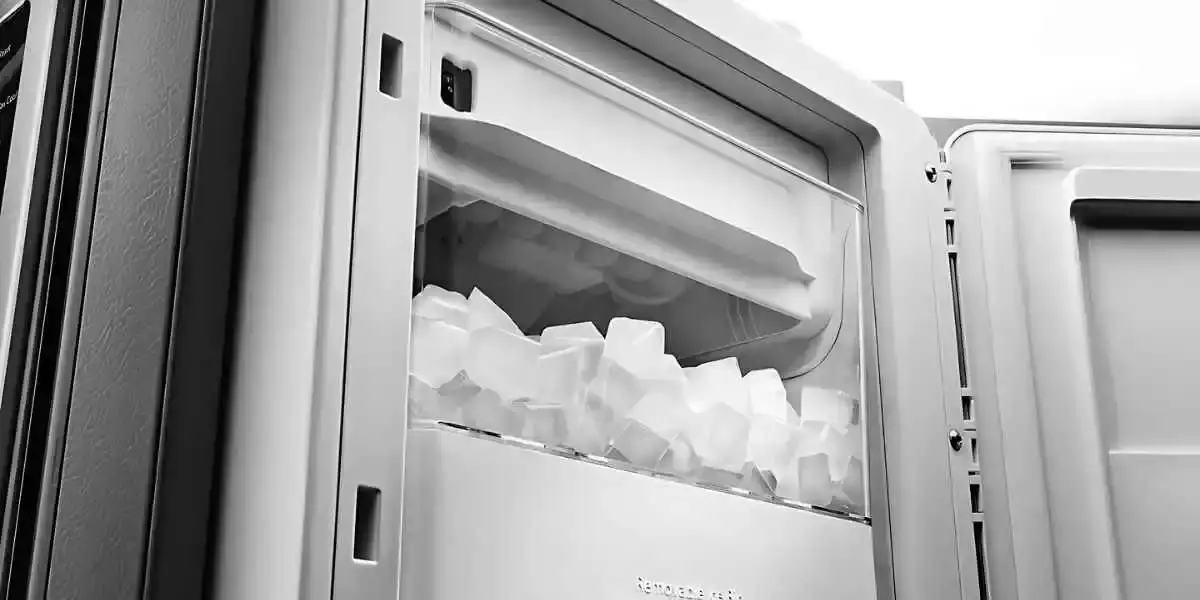
LG Refrigerator Ice Maker Overflows With Water
Is your LG refrigerator’s Twist-N-Serve ice maker overflowing with water? High water pressure may be the culprit.
Reduce the water pressure by partially closing the water valve, or consider using a water pressure regulator for a more controlled flow.
Keep your ice maker running smoothly.
10 Reasons For Ice Maker Overflows In LG Refrigerators
Faulty Water Inlet Valve:
One of the common causes of ice maker overflows in LG refrigerators is a faulty water inlet valve. The water inlet valve controls the flow of water into the ice maker.
When it malfunctions, it may not shut off properly, leading to an excessive flow of water.
As a result, the ice maker gets overwhelmed, and water spills out, causing an overflow.
To fix this issue, you may need to replace the faulty water inlet valve with a new one.
Defective Water Pressure
Regulator: A defective water pressure regulator can also contribute to ice maker overflows.
The water pressure regulator maintains a consistent water pressure level in the refrigerator.
If it fails to regulate the pressure effectively, the water flow into the ice maker can become too high, causing an overflow.
To resolve this problem, consider replacing the defective water pressure regulator with a functioning one.
Frozen Water Supply Line:
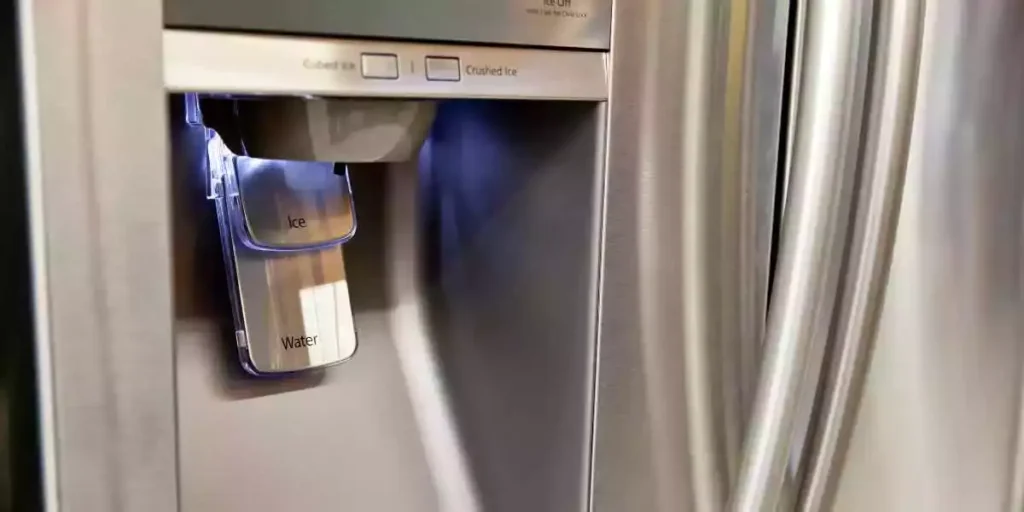
Another potential cause of ice maker overflows is a frozen water supply line. When the water supply line becomes frozen or partially blocked, it restricts the water flow to the ice maker.
As a result, water pressure builds up, leading to overflow.
To address this issue, you can thaw the frozen water supply line by turning off the refrigerator and allowing it to defrost.
Once thawed, ensure that the water supply line is clear and unobstructed.
Damaged Water Fill Tube:
A cracked or damaged water fill tube can also be a culprit behind ice maker overflows. The fill tube carries water from the inlet valve to the ice maker.
If it is damaged, water may leak into the ice maker continuously, causing it to overflow.
To fix this issue, inspect the water–fill tube for any cracks or damage. If necessary, replace the water-fill tube to prevent further leaks and overflow.
Incorrect Water Level Adjustment:
An incorrect water level adjustment in the ice maker can sometimes lead to overflows. The water level determines how much water fills the ice maker tray.
If set too high, the ice cubes may overflow the tray and spill into the freezer.
To address this issue, consult the user manual or the manufacturer’s instructions to adjust the water level properly.
Ensure that the water level is set according to the recommended specifications.
Clogged or Faulty Ice Maker Sensor:
A clogged or faulty ice maker sensor can disrupt the ice-making process and result in overflows. The sensor is responsible for detecting the ice level in the ice maker.
If it becomes clogged or malfunctions, it may fail to sense the ice level accurately. This leads to overfilling and subsequent overflow.
To resolve this issue, carefully clean the ice maker sensor or consider replacing it if necessary.
Improper Installation:
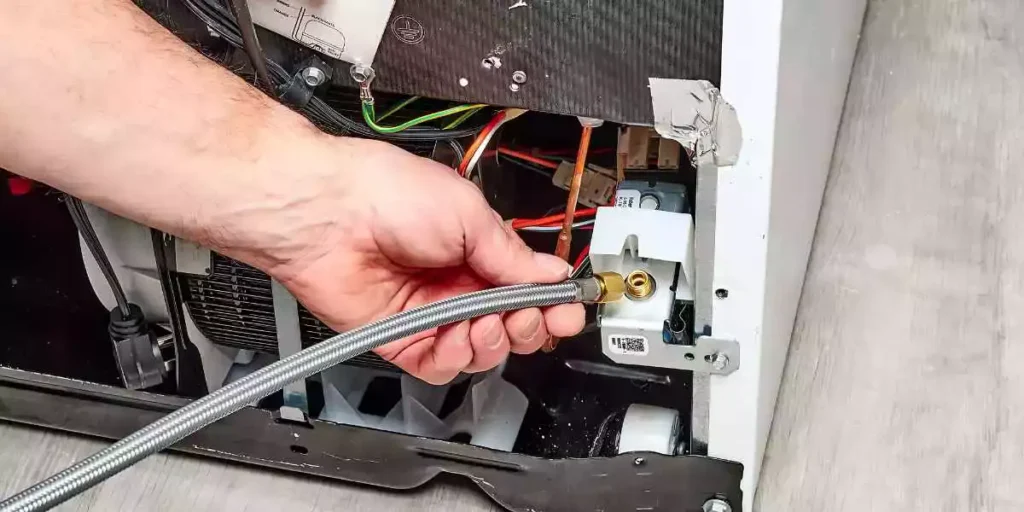
Improper ice maker installation or the water supply line installation can also contribute to overflow problems.
If the ice maker is not installed correctly or the water supply line is not properly connected. It can disrupt the water flow, leading to an overflow.
Ensure the ice maker and water supply line are installed correctly to address this issue.
Double-check all connections and make any necessary adjustments to ensure proper installation.
Aging or Worn-Out Ice Maker Components:
Over time, the various components of the ice maker can age or wear out, leading to overflow issues.
Components such as the water inlet valve or water level sensor may become less effective or malfunction, resulting in overflows.
High Water Pressure:
Excessive water pressure from the main water supply can overwhelm the ice maker and lead to overflows.
High water pressure can cause an increased water flow into the ice maker, exceeding its capacity and overflowing.
To address this issue, you may need to install a water pressure regulator to regulate the water pressure and prevent overflows.
Insufficient Drainage:
Insufficient drainage can also contribute to ice maker overflows. If the drain line is clogged or improperly positioned, it can hinder the proper drainage of excess water from the ice maker, leading to an overflow.
To resolve this issue, check the drain line for clogs or blockages. Clear any obstructions and ensure that the drain line is properly positioned to allow proper drainage of water from the ice maker.
Potential Risks And Consequences Of Ice Maker Overflow
Water Damage:
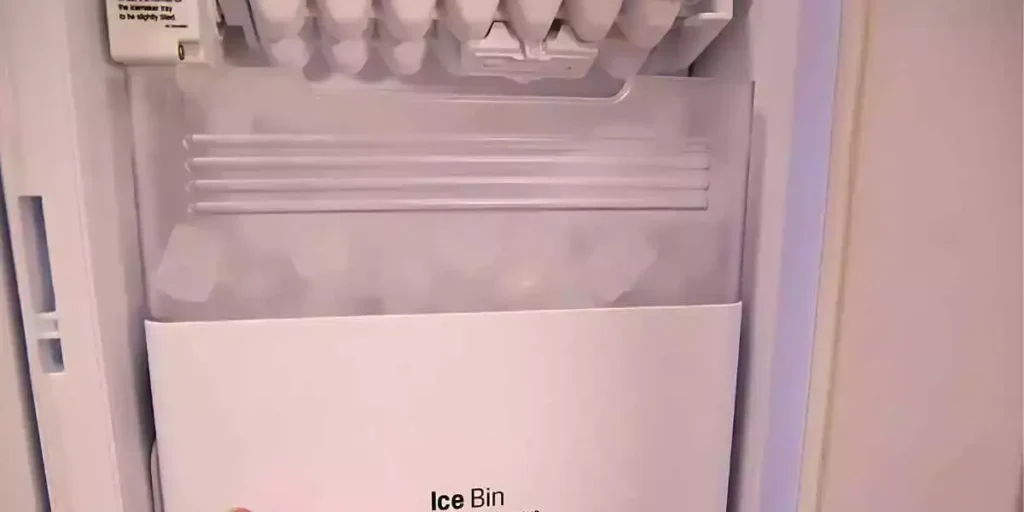
When an LG refrigerator ice maker overflows, it can result in water leakage and spillage.
This excess water can seep into your kitchen floor, cabinets, or adjacent areas, causing significant damage.
As the water spreads, it can warp wooden surfaces, deteriorate drywall, and even lead to mold and mildew growth.
Addressing this issue promptly prevents costly repairs and maintains a healthy living environment.
Electrical Hazards:
An overflow from the ice maker can also pose electrical hazards. If the water comes into contact with electrical connections or outlets near the refrigerator, it can cause short circuits.
This can lead to power outages or electrical fires in the worst cases.
These situations can put your safety at risk and may necessitate the involvement of professional electricians to assess and rectify the damage.
Freezer Compartment Malfunction:
An overflowing ice maker can result in water reaching the freezer compartment of your LG refrigerator.
When this happens, the excess water can freeze around the components, such as the evaporator fan or vents, impeding their proper functioning.
This can disrupt the cooling process, potentially causing the freezer temperature to rise and compromising the freshness and quality of your frozen foods.
Impaired Ice Production:
Another consequence of an overflowing ice maker is reduced ice production capacity.
When the ice maker overflows, freezing efficiency decreases, affecting ice cube formation.
This can be frustrating, especially if you rely heavily on the ice dispenser for beverages or entertaining guests.
Addressing the issue promptly can help restore average ice production and avoid inconveniences.
Food Spoilage:
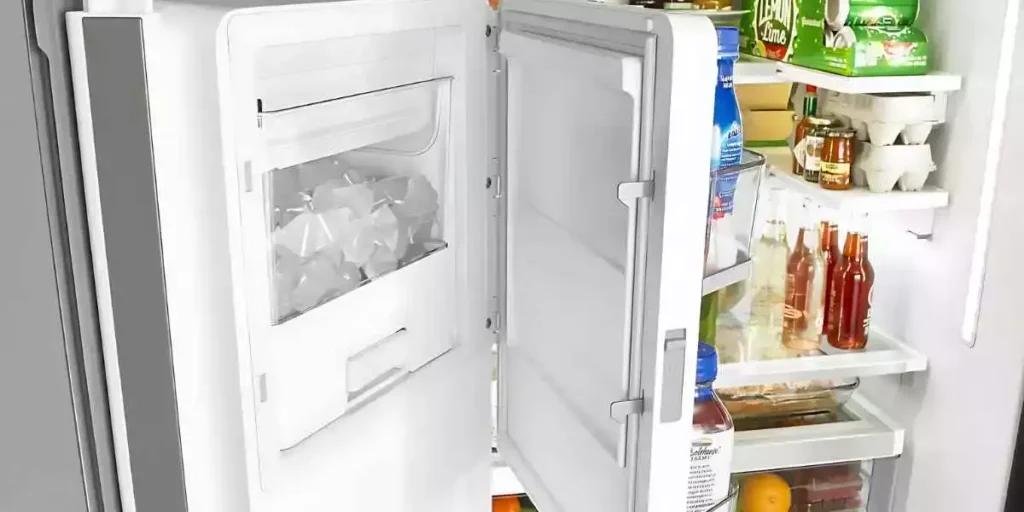
A malfunctioning ice maker can also result in food spoilage. When the freezer temperature rises due to water overflow, it can impact cooling and spoil food.
It’s important to monitor your refrigerator closely to ensure food safety.
Troubleshooting And Fixing An Overflowing Ice Maker
Check the Ice Maker’s Position:
Verify that the ice maker is properly positioned inside the freezer compartment of your LG refrigerator.
Ensure that it is securely attached and aligned correctly. If it is loose or misaligned, adjust it to its proper position.
Inspect the Water Fill Tube:
The water fills tube supplies water to the ice maker. Carefully examine it for any blockages or obstructions that may prevent water from flowing properly.
Clear any ice or debris that you find using a soft cloth or warm water.
Adjust the Water Inlet Valve:
The water inlet valve controls the water flow into the ice maker. Make sure it is fully open and functioning correctly.
If you notice any leaks or irregularities, consider replacing the valve to restore proper water flow.
Evaluate the Water Pressure:
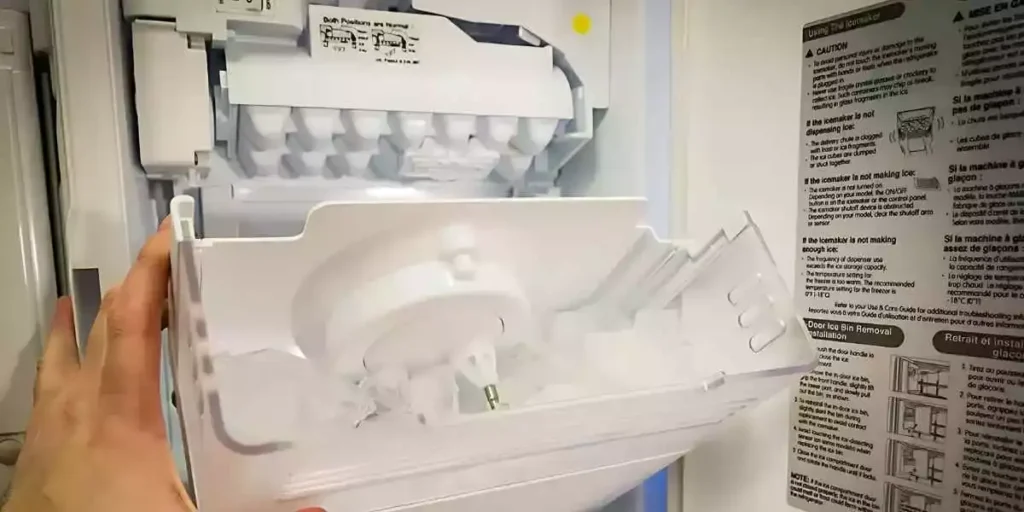
Insufficient water pressure can result in inadequate ice maker filling, causing it to overflow.
Check the water pressure in your home’s plumbing system. If it’s low, you may need to contact a plumber to address the issue.
Inspect the Water Filter:
A clogged or dirty water filter can restrict water flow, leading to an overflowing ice maker. Check the water filter in your LG refrigerator and replace it if necessary.
Examine the Ice Level Control Board:
The ice level control board regulates the ice maker’s operation, including the water fill cycle. Inspect it for any signs of damage or malfunction.
Monitor the Ice Maker’s Usage:
If you frequently use large amounts of ice or if the ice maker is under heavy usage, it may overflow due to the excess demand.
Allow the ice maker sufficient time to replenish the ice supply before using it again to avoid overflow.
Clean the Ice Maker and Freezer:
Regularly clean the ice maker and freezer to prevent the accumulation of debris, mold, or mildew, which can interfere with proper ice production.
Use a mild detergent and warm water to clean these areas thoroughly.
Maintaining Optimal Water Pressure For Your LG Refrigerator
Checking and Adjusting the Water Supply Valve
To maintain optimal water pressure for your LG refrigerator, the first step is to check and adjust the water supply valve.
Start by locating the valve behind the refrigerator near the floor. Ensure the valve is fully open by turning it counterclockwise.
If it’s already open, proceed to the next step.
Inspecting the Water Filter
Next, inspect the water filter in your LG refrigerator. Locate the filter, usually inside the refrigerator compartment or at the bottom front of the unit.
Remove the filter and check for any clogs or debris. If you notice any blockages, clean or replace the filter as necessary.
A clean filter allows for better water flow and helps maintain adequate water pressure.
Examining the Water Line
It’s time to examine the water line connected to your LG refrigerator. Carefully inspect the line for any kinks, bends, or damage. These can restrict water flow and affect pressure.
Straighten any kinks and ensure the line is properly connected at both ends. If you find any damages, replace the water line promptly to prevent leaks and maintain optimal water pressure.
Verifying the Water Inlet Valve
The water inlet valve plays a crucial role in regulating water pressure for your LG refrigerator. Locate the valve at the back of the unit near the bottom.
Ensure the valve is fully open by turning it counterclockwise. If it’s already open, proceed to the next step.
Checking the Water Pressure Regulator
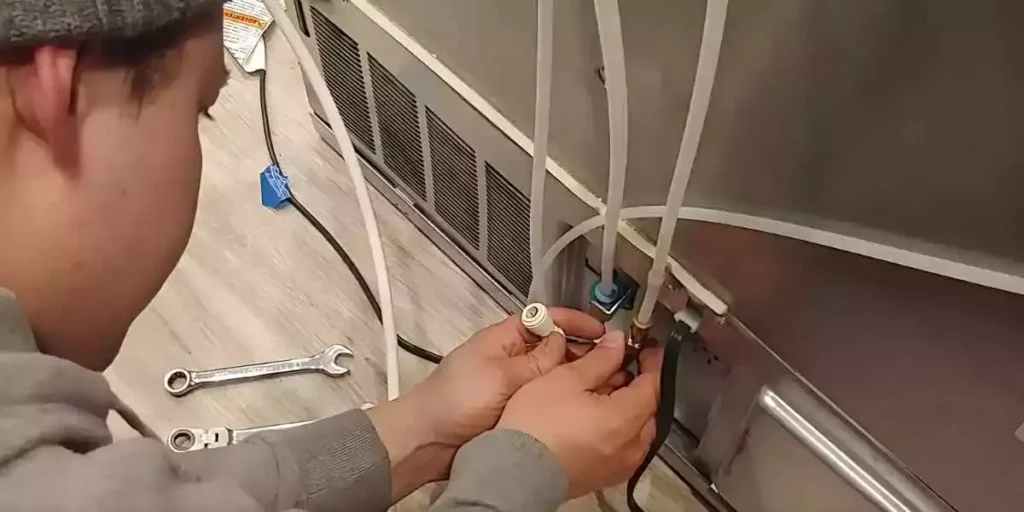
Sometimes, your home’s water pressure might be too high, causing issues with your refrigerator’s water pressure.
To address this, locate the water pressure regulator, usually installed near your main water supply line.
Adjust the regulator to decrease the water pressure, ensuring it stays within the recommended range for your LG refrigerator.
Consult the refrigerator’s user manual for specific pressure guidelines.
Inspecting the Water Dispenser Nozzle
Lastly, inspect the water dispenser nozzle on your LG refrigerator. This is the point where water is released.
Look for any blockages or build-up that may be affecting the water pressure.
Use a soft cloth or a toothbrush to clean the nozzle gently. This will help ensure a clear path for the water to flow, maintaining optimal pressure.
6 Steps To Prevent Ice Maker Overflow In LG Refrigerators
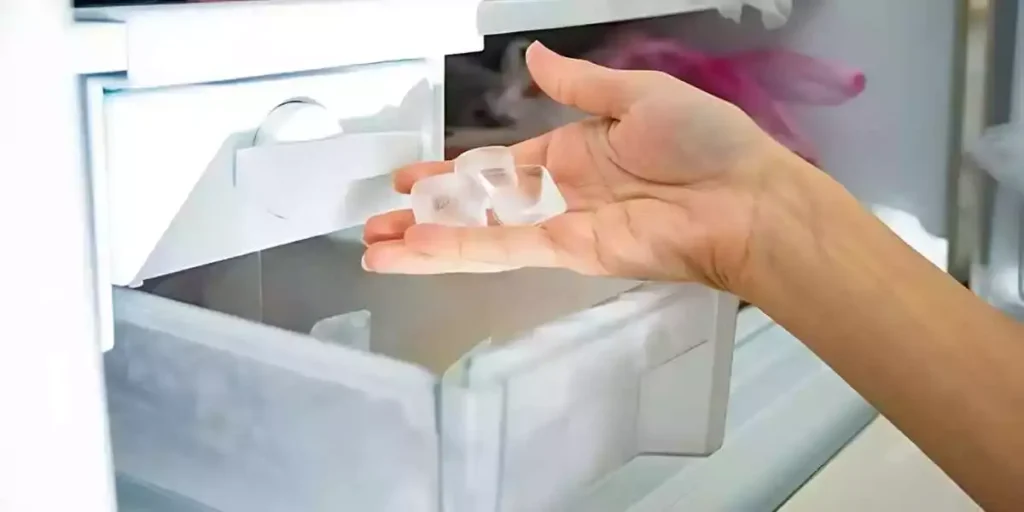
Step 1: Check the Water Inlet Valve
The first step in addressing this issue is to inspect the water inlet valve. Locate it at the back of your LG refrigerator.
Ensure that the valve is fully closed, as an open valve can cause excessive water flow and lead to an overflow situation. Gently turn the valve clockwise until it is tightly shut.
Step 2: Clear the Ice Maker’s Bin
Next, examine the ice maker’s bin. An accumulation of ice cubes or frost may obstruct the sensor or cause the ice maker to malfunction.
Remove any ice or frost buildup from the bin using a soft cloth or warm water. Ensure the bin is clean and free from any obstructions.
Step 3: Adjust the Water Pressure
Incorrect water pressure can also contribute to ice maker overflow. To address this, locate the water shut-off valve connected to your LG refrigerator.
Adjust the valve to reduce the water pressure. Turning it slightly in a clockwise direction should decrease the pressure.
Experiment with small adjustments until you find the optimal water pressure to prevent overflow.
Step 4: Inspect the Water Line
Now, it’s time to inspect the water line connected to your LG refrigerator. Check for any kinks, bends, or blockages that impede water flow.
Straighten any kinks or bends and clear any blockages. A clear and unrestricted water line will ensure proper water supply to the ice maker, minimizing the chances of overflow.
Step 5: Check the Ice Maker’s Fill Level
LG refrigerators often come with an adjustable fill level feature for the ice maker. It allows you to control the amount of water that enters the ice maker during each cycle.
Check the user manual or the control panel settings to locate this feature. Adjust the fill level to a lower setting, reducing the amount of water used for each batch of ice, and preventing overflow.
Step 6: Regularly Maintain and Clean the Ice Maker
To ensure the smooth functioning of your LG refrigerator’s ice maker, it is crucial to perform regular maintenance and cleaning.
Follow the proper instructions to clean the ice maker and remove any mineral deposits or debris that may hinder its performance.
Keeping the ice maker clean and well–maintained will minimize the chances of overflow.
Frequently Asked Questions About LG Refrigerator Ice Maker Overflows
Can a clogged water line cause an ice maker to overflow in an LG refrigerator?
Yes, a clogged water line can restrict the water flow to the ice maker, causing it to overflow.
The water line is free from any kinks, bends, or blockages to prevent this issue.
Why Does Adjusting The Ice Maker’s Fill Level Help Prevent Overflow?
Adjusting the ice maker’s fill level allows you to control the amount of water that enters the ice maker during each cycle.
By reducing the fill level, you can decrease the amount of water used for each batch of ice, preventing overflow.
How Often Should I Clean And Maintain The Ice Maker In My LG Refrigerator?
Regular cleaning and maintenance of the ice maker are essential. Follow the manufacturer’s instructions, but generally, performing this task every three to six months is recommended.
It helps prevent issues and ensures the proper functioning of the ice maker.
Can Using Filtered Water Prevents Ice Maker Overflow In LG Refrigerators?
Using filtered water can help prevent ice maker overflow to some extent.
It reduces the chances of mineral deposits or impurities clogging the water line or the ice maker’s components.
Conclusion
Having trouble with your LG refrigerator’s ice maker overflowing? No worries! You can fix it.
Reduce water pressure, check for faults, thaw supply lines, and ensure proper installation.
By addressing these issues, you’ll keep your ice maker working smoothly. Plus, you’ll avoid water damage, electrical hazards, freezer malfunctions, reduced ice production, and spoiled food.
Follow the above steps, maintain water pressure, and do regular maintenance to prevent overflow.

